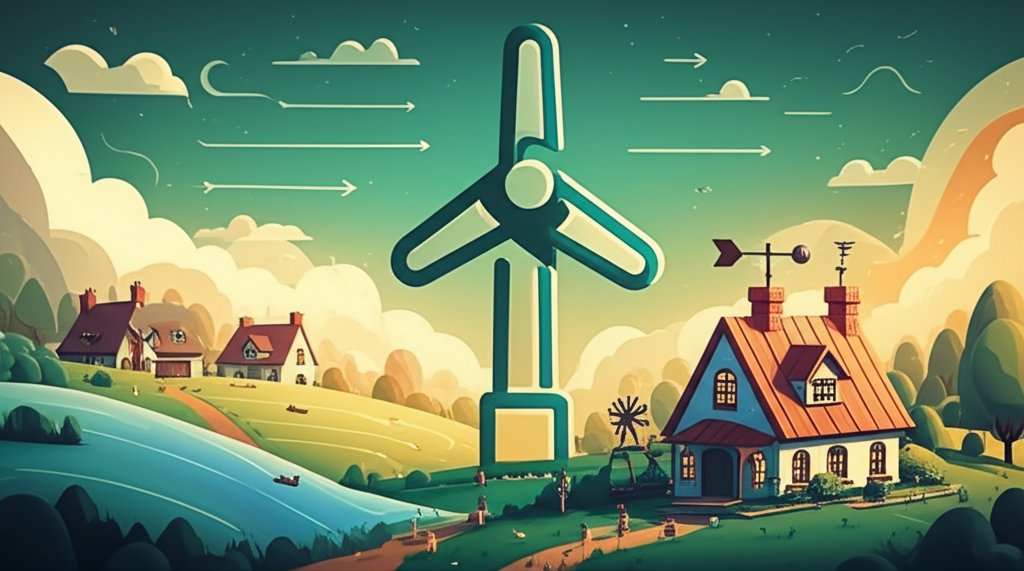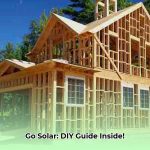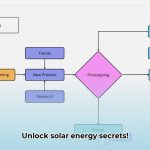Dreaming of slashing your electricity bill and sticking it to fossil fuels? Wind energy for residential use offers a tantalizing possibility, but it’s not a one-size-fits-all solution. Before you invest, let’s break down what it takes to make wind power a viable option for your home.
At a glance:
- Assess your location: Is your property windy enough year-round?
- Understand the costs: From turbine purchase to installation and maintenance, what’s the real price tag?
- Navigate regulations: Zoning laws and permits can make or break your wind energy dreams.
- Choose the right turbine: Different sizes and designs suit different needs and budgets.
- Calculate ROI: Will you actually save money in the long run?
Is Your Property Windy Enough for Residential Wind Energy?
The single most crucial factor determining the success of residential wind energy is wind speed. A turbine needs a consistent average wind speed to generate sufficient power.
- The 10 mph benchmark: Most small wind turbines require an average annual wind speed of at least 10 miles per hour to be economically viable.
- Where to find wind data:
- The US Department of Energy (DOE) provides wind resource maps: These are a good starting point, but they offer a general overview. Local wind conditions can vary significantly.
- Hire a professional wind assessor: A wind assessor will use anemometers to measure wind speeds on your property over a period of time. This is the most accurate way to determine if your site is suitable.
- Check local airport data: Airport weather stations often record wind speeds, but keep in mind that conditions at an airport can differ from those on your property.
- Understanding Turbulence: Wind turbines don’t like turbulence. Trees, buildings, and even hills can create turbulent airflow that reduces efficiency and can damage the turbine. Ensure your turbine will be positioned in a relatively open area with minimal obstructions.
Example: A homeowner in rural Kansas contacted three different wind assessors. Their reports varied slightly, but all indicated average wind speeds above 12 mph at a 100-foot tower height. This clear data gave the homeowner confidence to proceed with a turbine purchase.
Understanding Costs & Financial Considerations

Residential wind turbines are an investment, and understanding the costs upfront is essential. The financials break down roughly into these areas:
- Turbine purchase: Small wind turbines range widely in price, from $3,000 to $80,000 or more, depending on size and capacity.
- Installation: Installation costs can equal or exceed the turbine cost. This includes:
- Tower: Towers can be self-supporting or guyed (supported by cables). Taller towers capture stronger winds but are more expensive.
- Foundation: A concrete foundation is needed to anchor the tower.
- Electrical work: Connecting the turbine to your home’s electrical system requires a qualified electrician.
- Maintenance: Wind turbines require periodic maintenance, including:
- Inspections: Regular visual inspections can identify potential problems early on.
- Lubrication: Moving parts need to be lubricated to prevent wear and tear.
- Repairs: Blades can be damaged by storms, and other components may need to be replaced over time.
- Inverter Replacement: Inverters, which convert DC power from the turbine to AC power for your home, typically need replacement every 5-10 years.
Example: A homeowner purchased a $20,000 turbine. Installation costs, including the tower, foundation, and electrical work, totaled $25,000. Over the next 10 years, maintenance and repairs averaged $500 per year, and an inverter replacement cost $3,000. The total cost of ownership over 10 years was $50,000.
Navigating Regulations and Permits
Before you even think about buying a turbine, check local zoning laws and permit requirements.
- Zoning restrictions: Many municipalities have zoning regulations that restrict the height and placement of wind turbines. Some areas may prohibit them altogether.
- Permitting process: Obtaining the necessary permits can be time-consuming and expensive. You may need to submit detailed plans and undergo inspections.
- Noise ordinances: Wind turbines can generate noise, which may violate local noise ordinances. Check the decibel ratings of the turbine you’re considering.
- FAA regulations: If your turbine is located near an airport, you may need to comply with Federal Aviation Administration (FAA) regulations.
Case Snippet: A homeowner in a suburban area spent $5,000 on a wind turbine before discovering that local zoning laws prohibited turbines taller than 30 feet. The homeowner was forced to sell the turbine at a loss and abandon the project.
Don’t make costly mistakes. Thoroughly research local regulations before making any purchase. You can also use these professionally designed energy-themed flyers to meet your promotional needs. Design a wind energy flyer.
Choosing the Right Turbine
Not all wind turbines are created equal. Choosing the right turbine for your needs is critical.
- Horizontal Axis Wind Turbines (HAWTs): These are the most common type of wind turbine, with blades that rotate around a horizontal axis. They are generally more efficient than VAWTs.
- Vertical Axis Wind Turbines (VAWTs): These turbines have blades that rotate around a vertical axis. They are less efficient than HAWTs but can operate in more turbulent wind conditions.
- Size and Capacity: Turbine size is measured in kilowatts (kW). A typical residential wind turbine ranges from 1 kW to 10 kW. The right size depends on your energy needs and wind resources.
- Rated Wind Speed: A turbine’s rated wind speed is the wind speed at which it produces its maximum power output. Choose a turbine with a rated wind speed that matches the average wind speed at your location.
- Rotor Diameter: The rotor diameter is the diameter of the circle swept by the turbine blades. A larger rotor diameter captures more wind energy.
Sizing Example: A home uses 10,000 kWh of electricity per year. They want to offset 50% of their usage with wind power (5,000 kWh). With an average wind speed of 11 mph, a 5 kW turbine with a 10-meter rotor diameter might be suitable.
Calculating ROI: Will You Actually Save Money?

The return on investment (ROI) for residential wind energy depends on several factors, including:
- Turbine cost: As described earlier, this is a major factor.
- Installation costs: These can vary widely depending on site conditions.
- Electricity rates: The higher your electricity rates, the more you’ll save by generating your own power.
- Net Metering Policies: Net metering allows you to sell excess electricity back to the grid. This can significantly improve your ROI.
- Incentives and Rebates: Federal, state, and local governments offer incentives and rebates for renewable energy projects. These can reduce the upfront cost of a wind turbine.
- Maintenance costs: Factor in ongoing maintenance expenses.
Simple ROI Calculation:
- Calculate annual energy production: (Turbine Capacity in kW) x (Capacity Factor) x (8760 hours/year) = Annual kWh
- Capacity Factor: This is the actual energy output compared to the maximum possible output. Typical Capacity Factor for small wind is 20-40%.
- Calculate annual savings: (Annual kWh) x (Electricity Rate per kWh) = Annual Savings
- Calculate simple payback period: (Total Cost) / (Annual Savings) = Payback Period in Years
Important Note: This is a simplified calculation. A more accurate ROI analysis should consider factors like inflation, the time value of money, and potential changes in electricity rates.
Quick Answers: Common Questions About Residential Wind Energy
Q: How much noise do wind turbines make?
A: Small wind turbines typically produce noise levels of 50-60 decibels at a distance of 100 feet. This is comparable to the sound of a refrigerator or air conditioner.
Q: Can a wind turbine power my entire house?
A: It depends on your energy consumption and the size of the turbine. A small turbine may only offset a portion of your electricity needs.
Q: Are wind turbines dangerous to birds?
A: Larger wind farms pose a greater risk to birds than small residential turbines. However, it’s still important to consider the potential impact on local bird populations. Choose a turbine with a slow rotation speed and avoid placing it in areas with high bird activity.
Q: What happens when the wind isn’t blowing?
A: If your turbine is grid-tied, you’ll automatically draw power from the grid when the wind isn’t blowing. If you have a battery backup system, you can store excess energy for use during calm periods.
Q: Can I install a wind turbine myself?
A: While DIY installation seems appealing to save costs, it’s strongly discouraged. Working with electricity and heights is dangerous. Improper installation can damage equipment or cause serious injury. Always hire qualified professionals.
Your Next Steps: A Quick Start Guide
- Assess your wind resource: Use online tools and consider hiring a professional wind assessor.
- Research local regulations: Contact your local zoning department and building permit office.
- Get quotes from multiple installers: Compare prices and services.
- Review available incentives and rebates: Check federal, state, and local programs.
- Calculate your ROI: Determine if wind energy makes financial sense for your home.
Wind energy for residential use requires careful planning and consideration. By understanding the factors involved, you can make an informed decision about whether it’s right for your home. Don’t rush into a purchase without doing your homework.
- Wind Energy For Residential: Is It Right For Your Home? - November 28, 2025
- Wind Energy Flyer: Design a Powerful Green Campaign Show - November 26, 2025
- What Types Of Jobs Does Wind Energy Create? - November 23, 2025
















